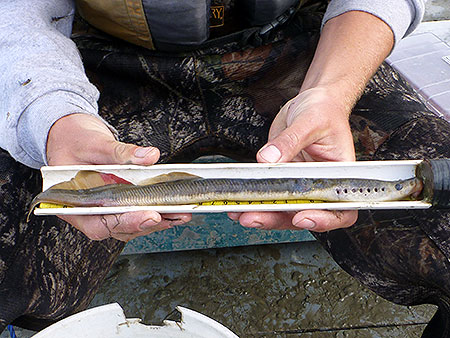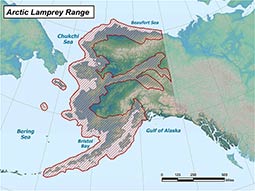Arctic Lamprey
(Lampetra camtschatica)
Printer Friendly
Did You Know?
Female lamprey may spawn with more than one male and can produce as many as 100,000 within a few weeks.
General Description
The Arctic lamprey is a small eel-like fish up to 15 inches in total length. Arctic lampreys are distinguished from other Alaska lampreys by two large teeth on the supraoral bar and the presence of a row of posterial teeth.
Adult Arctic lampreys are blue-black to dark brown on the dorsal side and yellow to light brown on the ventral side with light tan to gray fins. Adult Arctic lampreys have a dark blotch on the posterior dorsal fin and the tail. The body of juvenile Arctic lamprey is usually gray above and lighter below. The anal fin of the female Arctic lamprey is noticeably larger than that of a male, while female Arctic lampreys lack urogenital papilla.
Life History
Growth and Reproduction
Arctic lampreys are anadromous, which means it spends part of its life in the ocean and part of its life in fresh water. Anadromous Arctic lampreys may spend months moving to the cool, clear headwaters of streams to make their nest or redds. Both males and females participate in redd building in stream riffles by removing small rocks with their mouths and fanning smaller particles with their tails. Males and females intertwine while simultaneously depositing sperm and eggs into the redd. Depending on her size, a single female can release up to 100,000 eggs. The adults die soon after egg fertilization. The eggs hatch in freshwater in 7 to 14 days depending on the water temperature. Larval forms of lampreys, referred to as ammocoetes, are born without eyes and lack sucking mouthparts. Lampreys remain at this stage for three to seven years before metamorphosing in adults, which includes the development of a sucking mouth, eyes, and teeth.
Feeding Ecology
Ammocoetes burrow into the silt or mud of shallow pools and eddies of clear streams and feed by filtering microorganisms, algae, and detritus from the water. Anadromous adult lampreys parasitize other organisms such as other species of fish or even marine mammals by using their sucking mouthparts to attach themselves to the host's body. They then use their teeth to cut through the scales and skin to get to the host's blood and body fluid.
Migration
Parasitic adult lampreys migrate to the sea after metamorphosing into adults and tend to spend one to four years in the marine environment before returning to freshwater to eventually spawn. Anadromous lampreys return to fresh water in the fall and overwinter until spring when they spawn. Lampreys tend to migrate upstream in large groups and once upstream migration commences lampreys do not feed.
Range and Habitat
In Alaska, Arctic lampreys are found from the Kenai Peninsula north along Bering Sea drainages and east along the Arctic coast to the Anderson River. Arctic lampreys also occur in the Yukon, Kuskokwim, and Tanana river drainages and around St. Lawrence Island.
Status, Trends, and Threats
Status
Population discreteness for Arctic lampreys within and among river systems in Alaska is unknown, as very little information exists on Arctic lampreys in general. It is clear that an understanding of Arctic lamprey genetic population structure is necessary to identify appropriate management units for maintenance of biodiversity and productivity.
Trends
Overall strength of Arctic lamprey returns varies across the state by year and location. Why run strength remains strong in some areas while weak in other areas is unclear.
Threats
Potential overharvest from commercial, personal use or subsistence fisheries is the main threat to the resource.
Fast Facts
-
Size
The Arctic lamprey is a small fish known to reach a length of over 15 inches, but generally smaller. -
Range/Distribution
From the Kenai Peninsula north along Bering Sea drainages and east along Arctic Ocean drainage as far as the Anderson River. -
Diet
Juveniles are filter feeders of microorganisms and organic matter from the sediment. Adults feed by attaching parasitically to various species of fish such as salmon or sharks. -
Predators
A variety of fishes, birds, and river otters. -
Reproduction
Female Arctic lamprey can produce up to 100,000 eggs and die after spawning. -
Remarks
Managed by the Alaska Department of Fish & Game in Alaska state waters.
Did You Know?
- Adult lampreys are not eels but primitive fish that lack jaws, instead they have a disk-like mouth filled with small sharp teeth
- Juvenile lamprey lack eyes or the disk-like mouths of adult lamprey
- Female lamprey may spawn with more than one male and can produce as many as 100,000 within a few weeks.
Uses
In Alaska, anglers may dig through mud for juvenile Arctic lampreys to use for burbot bait, while harvest of adults occurs during subsistence fisheries. Arctic lampreys are captured using scoop nets or an eel rake, which consist of a long spruce pole with nails through the end so the sharp nail ends stick out like a rake. They are dried, smoked, or canned mostly for human consumption or dog food.
Management
Both commercial and subsistence fishers target Arctic lamprey. The Commercial Fisheries Division of ADF&s;G manages these fisheries in Alaska. Subsistence surveys are conducted by both Commercial Fisheries and Subsistence divisions. There are no directed sport fisheries for Arctic lamprey in Alaska.
Research
There is presently no ongoing department or federal research projects involving Arctic lamprey stocks in Alaska.
Get Involved
There are a number of ways to get involved in the regulatory process for Arctic lamprey. Since the State of Alaska is responsible for managing Arctic lamprey fisheries throughout the state, you can participate by attending Alaska Board of Fisheries (BOF) meetings, local advisory committee meetings or writing proposals to the BOF.
Alaska Board of Fisheries
The Board of Fisheries meets four to six times per year in communities around the state to consider proposed changes to fisheries regulations. The board uses the biological and socioeconomic information provided by the Alaska Department of Fish and Game, public comment received from people inside and outside of the state, and guidance from the Alaska Department of Public Safety and Alaska Department of Law when creating regulations that are sound and enforceable. The public can submit proposed changes and comment on proposals prior to deliberation through written or oral means. The public is also encouraged to participate in their local advisory committee. Eighty-one committees throughout the state provide recommendations to the BOF on a variety of issues. For more information see: Board of Fisheries


